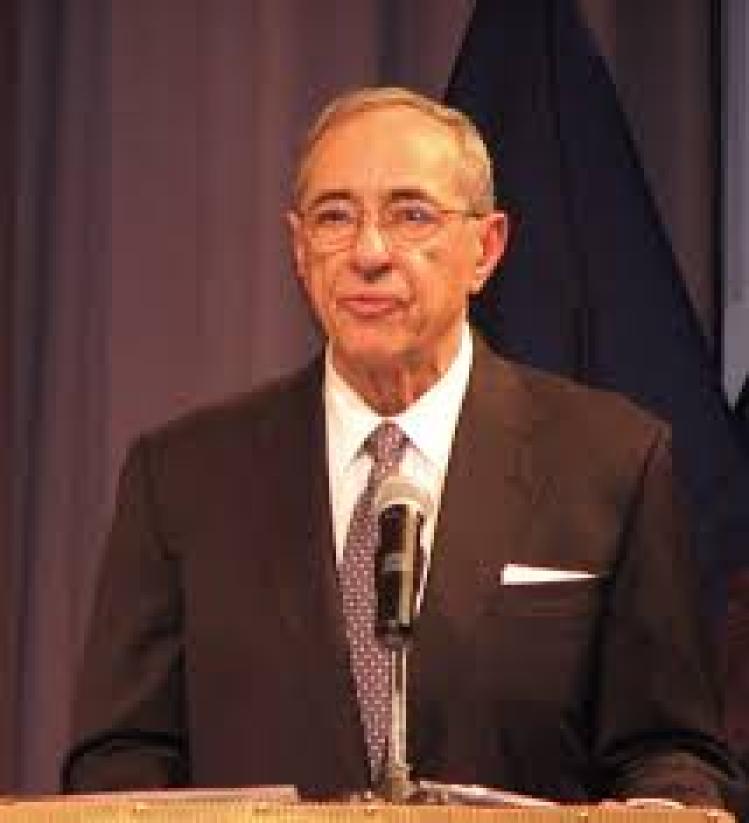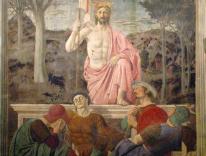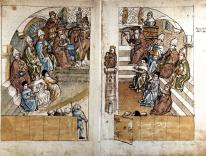
At Mass this morning, we remembered Mario Cuomo in our prayers. May he rest in peace. He was a brilliant, thoughtful, gifted politician, and a good man. He could powerfully articulate ideals and also mediate compromises, no small abilities and all too seldom found together. He also maintained an extensive, friendly, always civil although not always harmonious relationship with Commonweal. No wonder he is being remembered as the very model of a liberal Catholic. About that, however, I have my doubts.
Of course, we won’t know the truth about this complex individual until his private papers can be plumbed by biographers, and even then I wonder if there will be one sufficiently versed in Catholic matters to get beyond the idea that anyone who disagrees with bishops about abortion is ipso facto a liberal Catholic. Especially if he or she uses words like ipso facto.
Liberal Catholic is a stance built in good part on some important distinctions about how religiously grounded moral beliefs relate to law and the state. Here Cuomo doubtlessly qualified. He made important statements about those subjects. But it was not always easy to reconcile his statements with his actions as a political leader. The difficulty became most striking in the contrast between his courageous defiance of public opinion and political expedience in the case of capital punishment and his equivocating conformity in the case of abortion. The contrast led some people to consider his views hypocritical, others to consider them just incoherent. I think that they made a lot more sense if one recognized that, for all his quoting of Teilhard de Chardin, Mario remained an old-fashioned pre-Vatican II Catholic, a variant of what Jay Dolan, writing of Catholic immigrants and their offspring, termed “devotional Catholicism.” When it comes to discerning moral teaching in this view of the church, there is a sharp division of labor. The hierarchy teaches; the laity apply—with prudence. In this view, when confronted with a complicated moral problem, one does not think with the church, one agrees with the church. It took me awhile to learn this lesson about Cuomo.
In June 1984, as a Commonweal editor, I attended the televised press conference at which John O’Connor, newly appointed archbishop of New York, was asked a leading question by a journalist from a right-wing Catholic publication: Would the archbishop excommunicate New York Governor Cuomo for signing rather than vetoing legislation funding abortion for Medicaid recipients in the state. O’Connor, who actually had no canonical power to excommunicate anyone in the two dioceses (Albany and Brooklyn) where Cuomo lived, replied that he would have to think about it.
After the press conference I shared my umbrella with Ken Briggs, then chief religion reporter for the New York Times, as we walked west on 42nd St. toward the Times Square subway stop (me) and the Times office (Ken). Perhaps Ken was only trying to draw me out when he suggested that there was no news in the press conference. “Are you kidding?” I replied. “That threat to excommunicate Cuomo is going to be all over the tabloids tomorrow!” Ken made sure that it was in the Times as well. That was my introduction to what became perhaps the last serious attempt by a liberal Democrat to address the church-state dimension of the legalization of abortion.
Cuomo, who had been watching the O’Connor press conference on TV with his wife and son, was deeply offended. He did not deliver his full-throated response until September, when he took up a standing invitation to speak at Notre Dame on religion and public morality. Meanwhile he had mesmerized the Democratic convention as keynoter, and O’Connor had criticized the abortion stance of Geraldine Ferraro, Walter Mondale’s running mate. Not long before the Notre Dame speech, the editors at Commonweal received a draft. (So, as we later learned, had the editor of America and a number of others.) Commonweal had been editorializing on abortion since long before Roe v. Wade as well as publishing moral and legal analyses from a variety of perspectives. So we naively took the invitation to critique the draft at face value. Today I would not rule out that possibility, but I would give more weight to the shrewd tactic of seeding the ground among potentially sympathetic Catholic voices for a favorable reception of the speech. Perhaps Commonweal’s archives or one of my filing cabinets or closets contain the memo I wrote proposing some revisions and clarifications of the draft. I don’t recall that any were accepted.
With slight reservations, Commonweal welcomed Cuomo’s speech, seeing in it an affirmation of prudence as the virtue unavoidably governing any translation of moral principle into enforceable law and public policy. The reservations mainly turned on Cuomo’s seeming acceptance of a social consensus about legal access to abortion as fixed and unchangeable. Whatever the consensus, we argued that it might well be modified at various points, particularly by a Democratic leader so well equipped “to move his party away from its one-sided stance on this issue.”
Over the succeeding three decades, I have learned a bit about the drafting of Cuomo’s speech. I hope that someday we get the full story. I have reread the talk a number of times, most recently several hours ago. I am slightly less impressed each time.
The rhetorical skills are as fine-pitched as ever. The political judgments about totally banning abortion remain sound. So does the call to Catholics to support a “seamless garment” of programs assisting pregnant women and addressing issues from hunger to the arms race. What stands out at the same time is Cuomo’s pre-conciliar view of the church and its moral teachings. When he calls himself in the speech as “an old-fashioned Catholic” raised “in the pre-Vatican II church,” it may be more than a rhetorical gesture toward establishing credentials. When his discussion of “church teaching” focuses so extensively on “bishops,” it may be more than a reflection of the interventions of O’Connor and other hierarchs during that 1984 presidential campaign season. Although Cuomo occasionally refers to his and his wife’s “hearts and consciences” as formed by church teaching or to “instinct” about revering life, church teaching generally appears as something external, which he “as a Catholic” accepts or is “enjoined” to believe. The morality of abortion is not treated independently in virtue of right or wrong but dependently in virtue of church doctrine. There are glancing references to fetal life and its “potential,” but the unborn are scarcely visible actors in the drama Cuomo presents. At center stage throughout is “Catholic morality.”
In 1984 and up through my writing of A People Adrift (2003) I read the Notre Dame speech as a sophisticated alternative to the standard refrain of I-am-personally-opposed-to-abortion-but wouldn’t-impose-my-views, an alternative grounded in quite traditional Catholic reasoning about morality, law, and prudence,. But was it really? Was it a sophisticated alternative or, instead, a sophisticated elaboration?
Over the years, Cuomo repeatedly insisted on his adherence to church teaching but also fudged on any clear statement of belief, beyond this adherence, about the moral status of fetal life, preferring phrases about “respect” or “potential.” Furthermore, as I wrote in A People Adrift, “it became obvious that Cuomo was not going to spend any political capital whatsoever on the abortion issue. Having argued that he was constrained by lack of a public consensus opposing abortion, he backed away from even the mildest proposals that might have shaped such a consensus. His stance was in stark contrast to the one he took on capital punishment, where he was outspoken in trying to cement a consensus against it and adamant in vetoing the legislation that reflected the consensus for it. Catholics who had taken his Notre Dame speech as heartfelt were hard pressed to find either similar courage or consistency in his abortion policy.”
The last phrase about consistency was not entirely fair. Although Cuomo sometimes justified his opposition to the death penalty with utilitarian arguments about reducing crime overall, he believed deep down that executing people was wrong in itself, not because of what some moral authority stated or what public consensus would or would not tolerate. When it came to abortion, however, did he believe that the church rejected abortion because it was wrong or that it was wrong—for him, that is—because the church rejected it? More and more, it seemed the latter, an old-fashioned Catholic view of morality as “following the rules” because the church taught them.
Birth control was against the rules, and therefore, as he would say (usually for argumentative purposes), a sin. Abortion was against the rules, and therefore a sin. Indeed, despite their differences, he said, “in terms of our church teaching they are both fundamental sins.” Cuomo rightly defended the Catholic politician’s or citizen’s reliance on prudence to determine what sins should be legally prohibited. But he seemed to draw the line at the idea that the Catholic politician or citizen should look behind the rules, the “teachings,” for their underlying human meanings and, if any stood out as valid and universal and central to human life and dignity, then they should be proclaimed and pursued, with all due prudence, as compelling matters of public justice. Was this “sin” of abortion, for instance, one against human lives or one only against Catholic obedience? In all this, I came to believe that Cuomo was not as inconsistent as he appeared. Rather, he was, much more than I had realized, a consistent adherent to a familiar pre-conciliar understanding of Catholicism as an authoritative law book for living right and getting to heaven.
That certainly doesn’t mean he was anything less than intelligent. Clearly he was brilliant, sometimes, perhaps, too much so for his own good. (He took pride in his nuanced thinking, but to challenge his nuances was to invite, for journalists I knew, angry phone calls and for many others not dialogue but bullying or obfuscating cross-examination.) That doesn’t mean he was not profoundly committed to the public good and to the welfare of those in grave need. Like many old-fashioned pre-conciliar Catholic public servants, he most assuredly was. Smarts and public service and belief in government action did not start with Vatican II. A new ecclesiology did, however, and at least when it came to abortion I don’t think Cuomo ever quite got it.
Please email comments to [email protected] and join the conversation on our Facebook page.
Previous Story
With Friends Like These....
Next Story
The Conscience of Mario Cuomo

